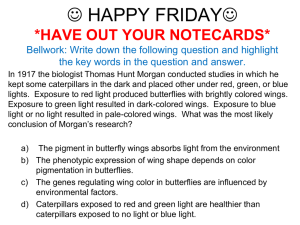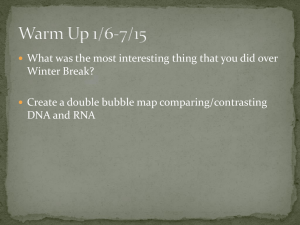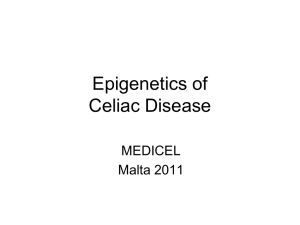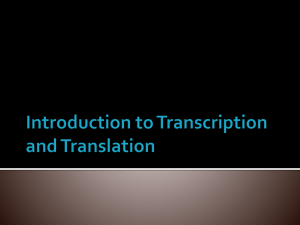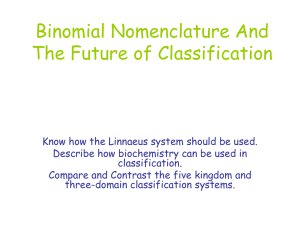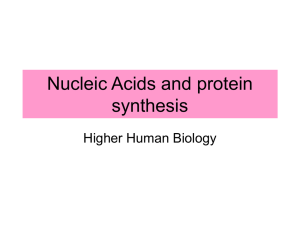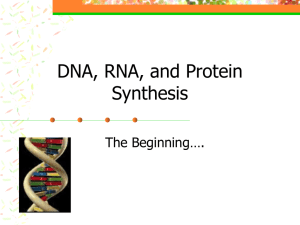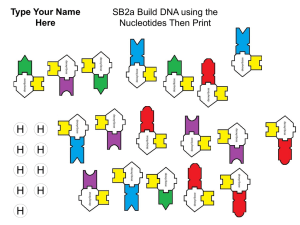Lecture 4a (1/28/13) "Central Dogma"
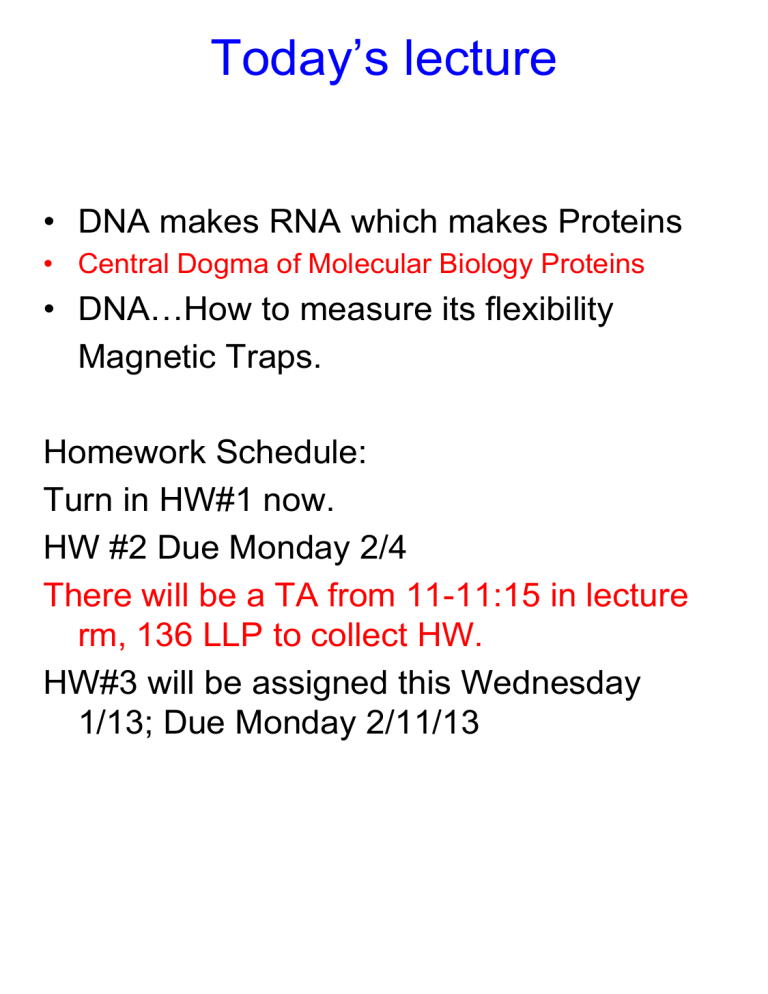
Today ’s lecture
• DNA makes RNA which makes Proteins
• Central Dogma of Molecular Biology Proteins
• DNA…How to measure its flexibility
Magnetic Traps.
Homework Schedule:
Turn in HW#1 now.
HW #2 Due Monday 2/4
There will be a TA from 11-11:15 in lecture rm, 136 LLP to collect HW.
HW#3 will be assigned this Wednesday
1/13; Due Monday 2/11/13
Minimal knowledge about Nucleotides
Make up DNA (also RNA)
• 4 nucleotides: A,T,G,C
(RNA: U replaces T)
• A=T ≈ 2kT two hydrogen bonds
G=C ≈ 4kT three hydrogen bonds
From Homework, you know that one or a few A-T or G-C bonds will come apart, but have a series of them, and the two halves always stay together, i.e. are stable.
T A T G C C A G G T C A A C
|| || ||||||||
A T A C G G T C C A G T T G
_|_|_|_|_|_|_|_|_|_|_|_|_|_|_
If DNA is very long, and have to unzip DNA, how does this happen?
Each strand held together by covalent bonds.
(Stable)
3.4 Å/base
An Enzyme which catalyzes reaction and puts energy
(in uses ATP)
∆G + forward
∆G + rev
∆G
Your DNA
You have 3 billion base-pairs, in 46 individual sections, called a chromosomes.
There are 23 pairs.
An X from mother; X or Y from father
(determines sex)
Slight shuffling of 1-23 chromosomes, called meiosis, such that you are different than the average of your parents.
http://ghr.nlm.nih.gov/handbook/basics/howmanychromosomes
Total Length DNA: (3.4 Å)(3 x 10 9 ) = 1 meter in every cell!
Nucleus of Cell ≈ 5 m m long
What does this tell you about the flexibility of DNA?
Learn about Magnetic Traps to measure Persistence Length.
Most Biopolymers in Body are in Cells
Bacteria
Prokaryotes
(No nucleus)
Eukaryotic cell (us)
(Has nucleus)
1 m m
10-30 m m
10-100 m m
(Nucleus 3-10 m m)
10 14 (50-100 trillion !) cells in body…
…more stars than in Milky Way Galaxy .
Yet there are
200 different types of cells in body. (Heart cell not equal to a brain cell…)
Each type of cell is diff. cause diff. parts of
DNA is turned on.
Every cell (except red blood cells) contains a nucleus which contains a copy of DNA – 1 meter
RBC: denucleated
DNA is a double helix of anti-parallel strands
3.4 Å
3.4 nm per
~10 base-pairs
= 1 turn (360
º)
Must come apart for bases to be read.
DNA
RNA
Proteins
Central Dogma of Molecular Biology
DNA : linear series of 4 nucleotides (bases): A,T,G,C
Double-stranded Transcription [DNA & RNA similar]
RNA : linear series of 4 nucleotides (bases): A, U ,G,C
Mostly single-stranded Translation [RNA & Proteins different]
Proteins : linear series of 20 amino acids: Met-Ala-Val-… each coded by 3 bases
amino acid
AUG
Methionine; GCU
Alanine; GUU
Valine
Proteins are 3-D strings of linear amino acids
Do everything: structure, enzymes… http://learn.genetics.utah.edu/units/basics/transcribe/
How to make nucleotide
Another Example of condensation reaction
Free H
2
O : lots of entropy gained
Reaction wants to go.
Covalent bonds holding bases together —very strong
3 ’
5 ’
If add salt to solution, what is effect on melting Temp?
Melting temp = Temp. at which DNA strands come apart .
DNA is twisted & antiparallel for base pairing
Thymine
Adenine
Cytosine
Hydrogen Bonds
Guanine
(2kT)
G-C more stable than A-T
Minor grove
Major grove
– stacking keeps it together (Grease);
Phosphate negative charge makes it water soluble
(Sort of like soap)
DNA Replication
Chicken & Egg Problem
Have already shown that
If DNA is long and therefore very stable, how can it replicate itself without an enzyme
(to lower the activation energy)?
(Nowadays, it uses DNA polymerase, which is an enzyme, i.e. protein.)
The answer won a Nobel prize!
Involves RNA… implications for the start of life on earth.
Difference between RNA and DNA is the Sugar + 1 Base (T, U)
RNA is a string of nucleotides, just like DNA
Larger groove (than DNA)
—more likely to be attacked by enzymes)
RNA substitutes Uracil for Thymidine
Uracil will base pair with many groups.
Methyl group restricts uracil
(thymine) to pairing only with adenine
.
Thymidine greatly improves the efficiency of DNA replication, by reducing the rate of mismatches, and thus mutations.
Also, methylation protects DNA from viruses.
RNA can be it ’s own enzyme!
RNA can be a ribozyme –a ribo nucleic acid and en zyme –is an
RNA molecule with a well defined tertiary structure that enables it to catalyze a chemical reaction. It contains an active site made completely of RNA. Can cut either itself or another RNA.
http://en.wikipedia.org/wiki/Ribozyme
Used by nature! The ribosome, used to make proteins from RNA, is itself a ribozyme
(involves RNA cutting by another RNA).
2009 Nobel Prize (Ramakrishnan, Cambridge;
Steitz, Yale; Yonath; Weizmann)
RNA solves the chicken & egg problem
From Nobel Lecture
The discovery of catalytic properties in RNA also gives us a new insight into the way in which biological processes once began on this earth, billions of years ago. Researchers have wondered which were the first biological molecules. How could life begin if the DNA molecules of the genetic code can only be reproduced and deciphered with the aid of protein enzymes, and proteins can only be produced by means of genetic information from DNA?
Which came first, the chicken or the egg? [Sid] Altman and [Tom]
Cech have now found the missing link. Probably it was the RNA molecule that came first. This molecule has the properties needed by an original biomolecule, because it is capable of being both genetic code and enzyme at one and the same time.
Presentation Speech by Professor Bertil Andersson of the
Royal Swedish Academy of Science, December 10, 1989
RNA can be catalytic!
Life probably started with RNA (not DNA)
1989 Nobel Prize —Altman & Cech
(1967 Carle Woese suggested RNA can be catalytic
—won the equivalent of Nobel Prize)
It is now possible to make ribozymes that will specifically cleave any RNA molecule. These RNA catalysts may have pharmaceutical applications. For example, a ribozyme has been designed to cleave the RNA of HIV. If such a ribozyme was made by a cell, all incoming virus particles would have their
RNA genome cleaved by the ribozyme, which would prevent infection.
Evidence that RNA have these properties?
